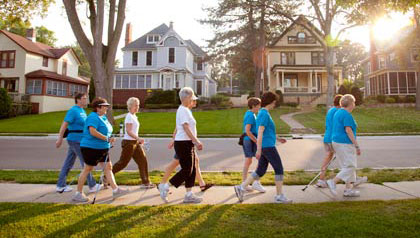
Moai Walking Group at Blue Zone in MN. Image source: AARP
2. Know your Purpose: People who know why they wake up in the morning live up to seven years longer than those who don’t. Read more about purposeful aging here.
3. Down Shift: To reverse inflammation related to every major age-related disease, find time each day to meditate, nap, pray, or enjoy a happy hour.
4. 80% Rule: It takes your stomach 20 minutes to tell your brain it is full causing most people to accidentally overeat; so stop when you feel 80% full.
5. Plant Slant: Eat mostly a plant-based diet that is heavy on beans, nuts, and green plants. This is consistent with the USDA’s MyPlate recommendations to make fruits, vegetables and grains the majority of your intake.
6. Wine at 5: If you have a healthy relationship to alcohol, one to two glasses of wine daily could help add years to your life, especially when consumed with a healthy diet.
7. Family First: Living in a thriving family is worth a half a dozen extra years of life expectancy. Invest time in your kids, nurture a monogamous relationship, and keep your aging parents nearby.
8. Belong: Recommit, reconnect, or explore a new faith-based community. No matter which faith, studies found that people who show up to their faith community four times a month live an extra 4 to 14 years.
9. Right Tribe: Your friends have a long-term impact on your well-being. Expanding your social circle to include healthy-minded, supportive people might be the most powerful thing you can do to add years to your life.
Fredericksburg Elder Law Attorney: 540-479-1435
Rockville Elder Law Attorney: 301-519-8041
DC Elder Law Attorney: 202-587-2797














Leave a comment
You must be logged in to post a comment.